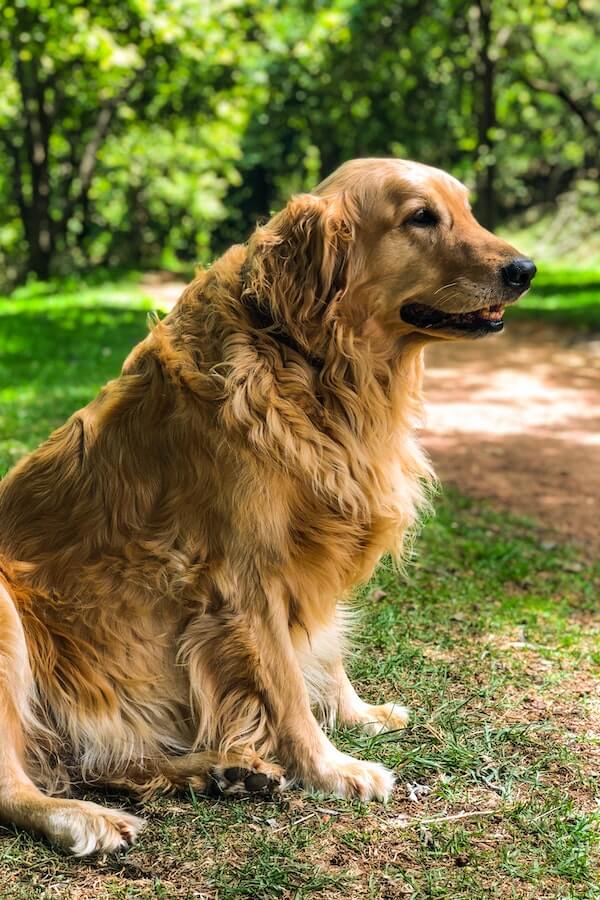
Have you ever gone to the park, seen a chubby pup rolling around in the grass, and thought, “Aww, look how cute he is!” Well if that pup is yours, then you should ask yourself: How can I tell if my dog is overweight?
Being overweight in dogs can lead to many health issues such as diabetes and joint problems. Keeping your pup healthy will help them live a longer and happier life.
Read on to learn more about how you can identify an overweight dog and what steps you can take to get them back into shape.
How can I tell if my dog is overweight?

If you want to know if your pup is a bit too porky for their own good, here are 8 indicators that may help you figure it out:
1. How does your pooch look from the side?
When looking at them from the side, an overweight dog will appear to have a higher tummy than is usual, and the lower back region may seem oddly shaped instead of having a smooth curve.
2. What’s their waistline look like?
A noticeable difference between their ribcage and hindquarters can be a sign of excess weight. If they don’t show any kind of taper around the midsection area, then it could be time to put down the treats – at least for now.
3. How’s their coat?
A dog that’s at a healthy weight typically has a shinier and thicker coat than one who is overweight.
4. How are they on the scales?
If your pup weighs more than what’s recommended for their breed, size, and age then this could be an indicator of excessive bulkiness.
5. How do they move?
An obese pooch may struggle with activities that are otherwise easy to them; if you notice your pup tiring easily or having difficulty jumping onto furniture, it could be due to extra pounds.
6. How do they act when eating?
If you find yourself needing to constantly give them more food or treats, then they may be eating too much and putting on weight.
7. How do they look from the top?
An overweight pooch will have a pot-belly appearance when viewed from above.
8. How do they compare to other dogs?
Comparing your pup’s size to that of others can be a great way to determine if your pup is at an ideal weight; if yours appears larger than their peers, it could mean that there’s extra fluff on board!
If you notice any of these indicators in your canine companion, it may be time for some healthy lifestyle changes for your pup.
How can my overweight dog lose weight?

If you determine that your dog needs to lose a few pounds (or many), here are 10 tips to help get them back on track.
1. Swap high-calorie treats for low-calorie alternatives, like carrot sticks or a handful of blueberries.
2. Measure your pup’s food and stick to the recommended serving size. Most bags of dog food provide feeding instructions based on weight, age, and activity level.
3. Dedicate time each day for exercise: take your pup on longer walks or run around with them in the yard (not just a potty break).
4. Try interactive toys: certain toys make it difficult for dogs to get their snacks out; this encourages problem-solving while keeping them entertained and active!
5. Avoid overfeeding: if you feel like you’re overfeeding, measure out the food and compare it to the recommended serving size.
6. Implement a feeding schedule: this helps control your pup’s calorie intake while also keeping them mentally stimulated throughout the day.
7. Add fiber-rich foods like sweet potatoes or pumpkin to their diet: fiber has no calories but takes up space in the stomach; this makes dogs feel full without additional calories.
8. Utilize portion-controlled meal delivery services designed specifically for overweight pets: these are great because you receive pre-measured portions of healthy food tailored to your pup’s weight goals!
9. Only reward good behavior with treats and affection instead of food; this helps your pup understand the difference between hunger and wanting a reward.
10. Finally, consult with your veterinarian: they can offer personalized advice on how to safely help your pup reach their goals!
Following these 10 tips will get your pup back into top shape in no time — and may even have you barking for joy over the results!
Conclusion

Keeping an eye on your pup’s weight is important in ensuring their overall health and well-being, and it can be done quite easily. How can you tell if your dog is overweight?
Check if they look rounded when viewed from above, or if their waist has disappeared when viewed from the side. If any of these signs are present, your furry friend might be putting on a few too many pounds.
Take them to visit the vet for a professional diagnosis, and start implementing diet and exercise changes as soon as possible! With some dedication and perseverance, you’ll have a healthy pup in no time.


GIPHY App Key not set. Please check settings